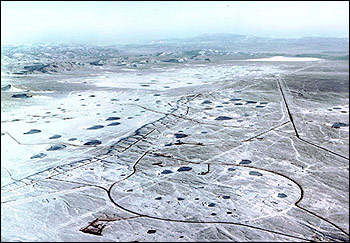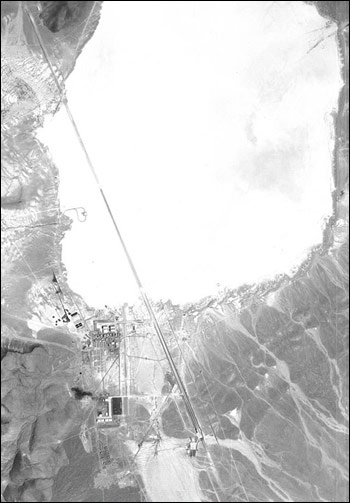History of Nellis Range, Nevada Test Site and the Groom Lake Facility |
|
Nellis Range
The largest above-ground test was codenamed Hood with a yield of approximately 74 kilotons or 74 thousand tons of TNT. When the Limited Test Ban treaty of 1962 went into effect, the testing went underground. From 1962-1992, around 800 below-ground tests of nuclear weapons were done at the test site, pockmarking the landscape [see graphic below]. The largest of these were in excess of 100 kilotons and formed craters several hundred feet deep.  U.S. Department of Energy photograph
When a U-2 was shot down on a reconnaisance overflight of the Soviet Union, its successor was already in development at "Dreamland" (as the airspace around the base is called by pilots). The SR-71 Blackbird was an aircraft designed to fly at Mach-3 at the edge of the atmosphere, well beyond the reach of Soviet missles. After housing the development and flight testing of the SR-71 (also known as the A-12), Dreamland began to diversify its operations. An operation to reverse-engineer foreign aircraft was began in 1967. The precursors to the F-117A Stealth Fighter began flight-testing in the late 1970s and was home to the aircraft until it was unveiled to the public in 1990.  1968 U.S.G.S. Photograph of Groom Lake
Soon, Area 51 became a media sensation. It appeared in The New York Times, Popular Science, network nightly news programs, and many other forms of media. The Little A'Lee'Inn (pronounced alien) became a popular tourist destination because of its central location on that same stretch of highway north of the Black Mailbox. The base was featured in the movie Independence Day, though in a way that was anything but accurate. Due to all this popularity, the Air Force seized several thousand acres and two popular vantage points around the base in April 1995. Since then, the hype has died down. You can still visit the all the places mentioned above (outside the restricted line, that is); they continue draw visitors daily. |
Eric Boyd, April 2001 - For Technical Communication, English 271
Last updated: 16 April 2001
Last updated: 16 April 2001